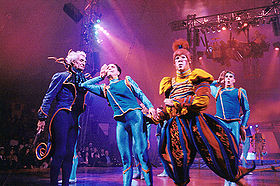- Nouvelle Expérience
-
Nouvelle Expérience 
Company Cirque du Soleil Genre Contemporary circus Show type Touring production Date of premiere May 8, 1990 Final show November 21, 1993 Creative team Director Franco Dragone Director of creation Gilles Ste-Croix Set designer Michel Crête Composer René Dupéré Costume designer Dominique Lemieux Lighting designer Luc Lafortune Choreographer Debra Brown Sound designer François Bergeron Other information Featured acts Contortion
Korean plank
Solo trapeze
Tightrope
Acrobatics
Aerial straps
Trapeze
Foot juggling
Russian bars
Trampoline
Korean cradle
Balancing on chairsNouvelle Expérience was Cirque du Soleil's fourth touring circus show, which premiered in 1990. The show's tour ended in 1993 in The Mirage parking lot in Las Vegas, Nevada. Over 1.3 million people saw the production during its 3½-year run.
Contents
Cast
- Flounes: The fallen angels. Dressed in browns and ochres.
- Devils: The spirits of disobedience. Dressed in reds.
- Corporation: The slaves of the world. Dressed in blue.
- Madame Corporation/Enterprise: Queen of the Flounes, and along with the Great Chamberlain, ruler of the Corporation.
- Great Chamberlain (aka Ringmaster): Madame Corporation's right-hand man.
- Everyman: Dressed in a brown suit, he represents all of us.
Acts
The acts of Nouvelle Expérience blend theatre, music, circus arts and dance.[1]
- Contortion: Four women, clad in pink, take to a suspended platform. The four twist and bend themselves into unbelievable positions. (Performed to "Meandres" on the soundtrack)
- Korean plank: Madame and the Corporation approach a seesaw-like object in the middle of the stage. They begin to jump on the ends, bouncing the opposite performer into the air. Soon, they begin performing twists and spins, and even form towers by flipping acrobats onto other acrobats' shoulders. (Performed to "Bascule" on the soundtrack.)
- Solo trapeze: An odd introduction happens between one of the Flounes and the Everyman. Afterwards, a woman takes to the stage, and is lifted towards a trapeze. She begins a beautiful number above, while flounes and devils watch from below. (Performed to "Fixe", "Ballant", and "Baleines" on the soundtrack)
- Fil de fer: One of the flounes moves about on a wooden ball. He spins, dances, and jumps until the Everyman enters the stage. At this point, the Everyman and the Floune try to shake hands again, but this attempt is successful. They begin to dance until the four other flounes enter near backstage. They take the fifth floune's ball, do a little trick with a quilt, and it reveals a tightrope walker. The man jumps up onto his tightrope (which is five or so feet high) and begins to perform many tricks. The ringmaster gives it a try and fails miserably. The two switch off, and the ringmaster gets better and better until the two are performing together.
- Fanfare: A little parade led by Madame Corporation introduces the next act. (Performed to "Fanfare" on the soundtrack)
- Aerial straps: A muscular man approaches two leather straps hanging from the ceiling. He takes to the straps and takes flight. He spins, flips, and hangs to a lyrical cello piece entitled "L'oiseau".
- Trapeze: Six figures climb three rope ladders up to an unusual flying trapeze apparatus. There is one regular trapeze, a two-layered trapeze, and a Russian trapeze. They swing back and forth between the three, performing daring tricks. (Performed to "Azimut" and "Sanza" on the soundtrack)
- Foot juggling: Two beautiful oriental women take to the stage. First, one begins to spin umbrellas on her feet and hands. Soon, she is juggling the other girl, and the other girl is spinning cloths on her feet. (Performed to "Suite Chinoise" on the soundtrack)
- Russian bar/Trampoline/Korean cradle: Three acts are combined into one (Performed to "Eclipsé" on the soundtrack):
- Russian bar – A 5-inch-wide bar held by two men across their shoulders, while a third bounces on it.
- Trampoline
- Korean cradle – Two men are strapped in on platforms, and take women by their hands to swing and flip them between one another.
- Balancing on chairs: A man dressed in white takes to the stage, a few chairs in his hands. He begins to stack the chairs and balance on them, along with a flaming birthday cake. (Performed to "Havi Vahila" on the soundtrack)
Costumes
The costumes of Nouvelle Expérience were designed to complement the wood theme of the set. Dominique Lemieux, costume designer, combined many different styles for the highly theatrical costumes, which makes it difficult to pin them down to any specific period. Surprisingly, some of the costumes worn are lined with upholstery material which make them very heavy. For example. the Flounes' medieval-esque costumes, made of a mix of lycra, velvet, and satin, weigh over 9 kilograms (20 lb).[2]
Music
The show's original score was composed by René Dupéré and performed live by five musicians. A studio album of the music was released in 1990 and again in 1993. The tracks of which are listed below.
- Fanfare
- Méandres
- Boléro
- Bascule
- Fixe
- Ballant
- Baleines
- Havi Vahlia
- Suite Chinoise
- Éclipse
- L'Oiseau
- Azimut
- Sanza
- Grosse Femme
Further information: Cirque du Soleil discographyReferences
- ^ "Nouvelle Expérience: Acts". Cirque Tribune. http://www.cirquetribune.com/database/show.php?show=Nouvelle%20Exp%E9rience. Retrieved 2011-02-16.
- ^ Clément, Ronald (2009) (in CN, EN, FR, JP). Cirque du Soleil 25 Years of Costumes. Canada: Dépôt légal, Bibliothèque et Archives Canada. pp. 14–15. ISBN 978-2-9803493-4-8.
Cirque du Soleil shows Touring showsArena Grand Chapiteau Retired Banana Shpeel · Le Cirque Réinventé · Delirium · Fascination · Le Grand Tour du Cirque du Soleil · La Magie Continue · Nouvelle ExpérienceResident showsLas Vegas Criss Angel Believe · Kà · Love · Mystère · O · Viva Elvis · Zumanity · Michael Jackson: The Immortal World TourNorth America Iris · La NoubaAsia Zaia · ZedRetired WintukNoted Special EventsNorth America Les Chemins invisiblesCategories:
Wikimedia Foundation. 2010.
